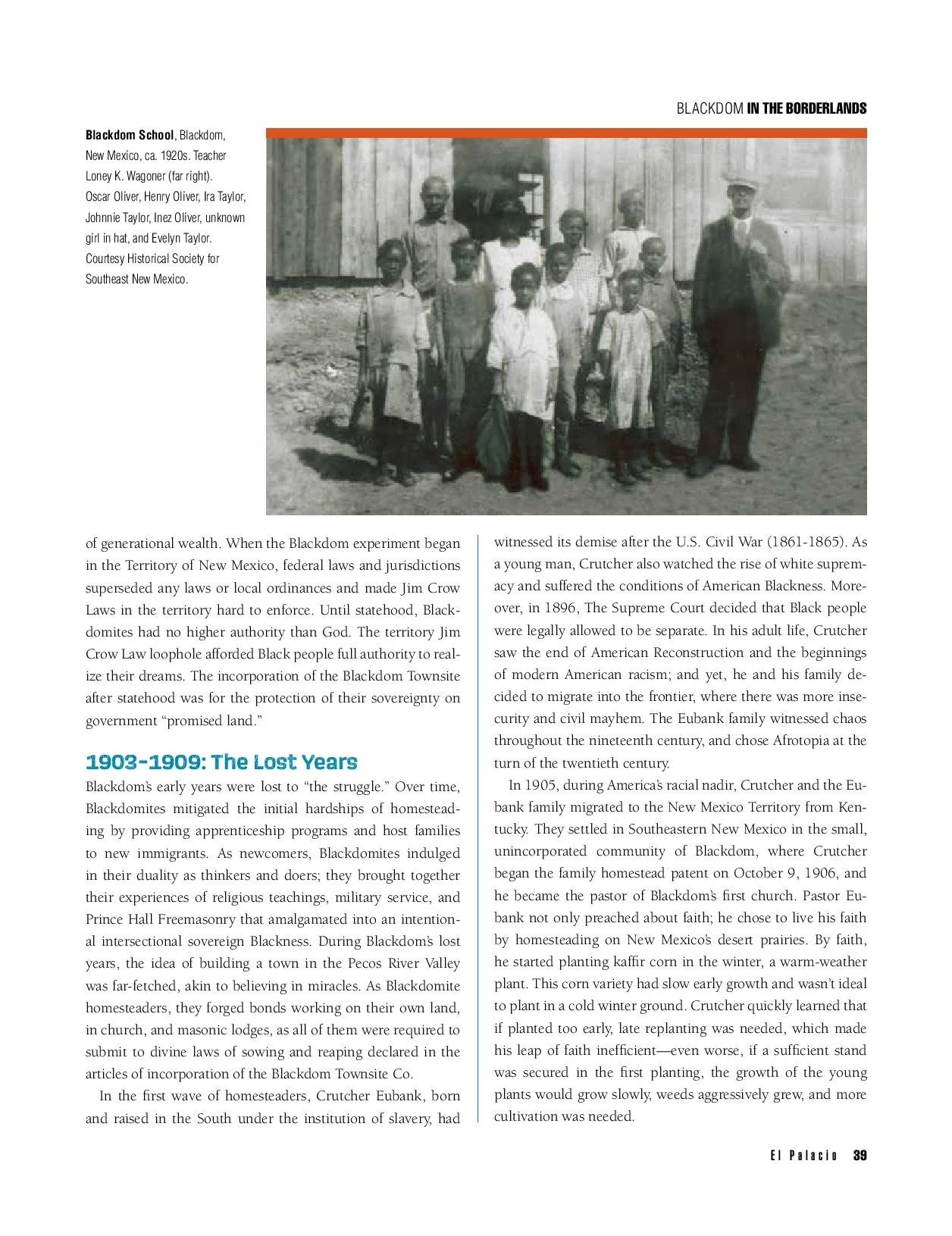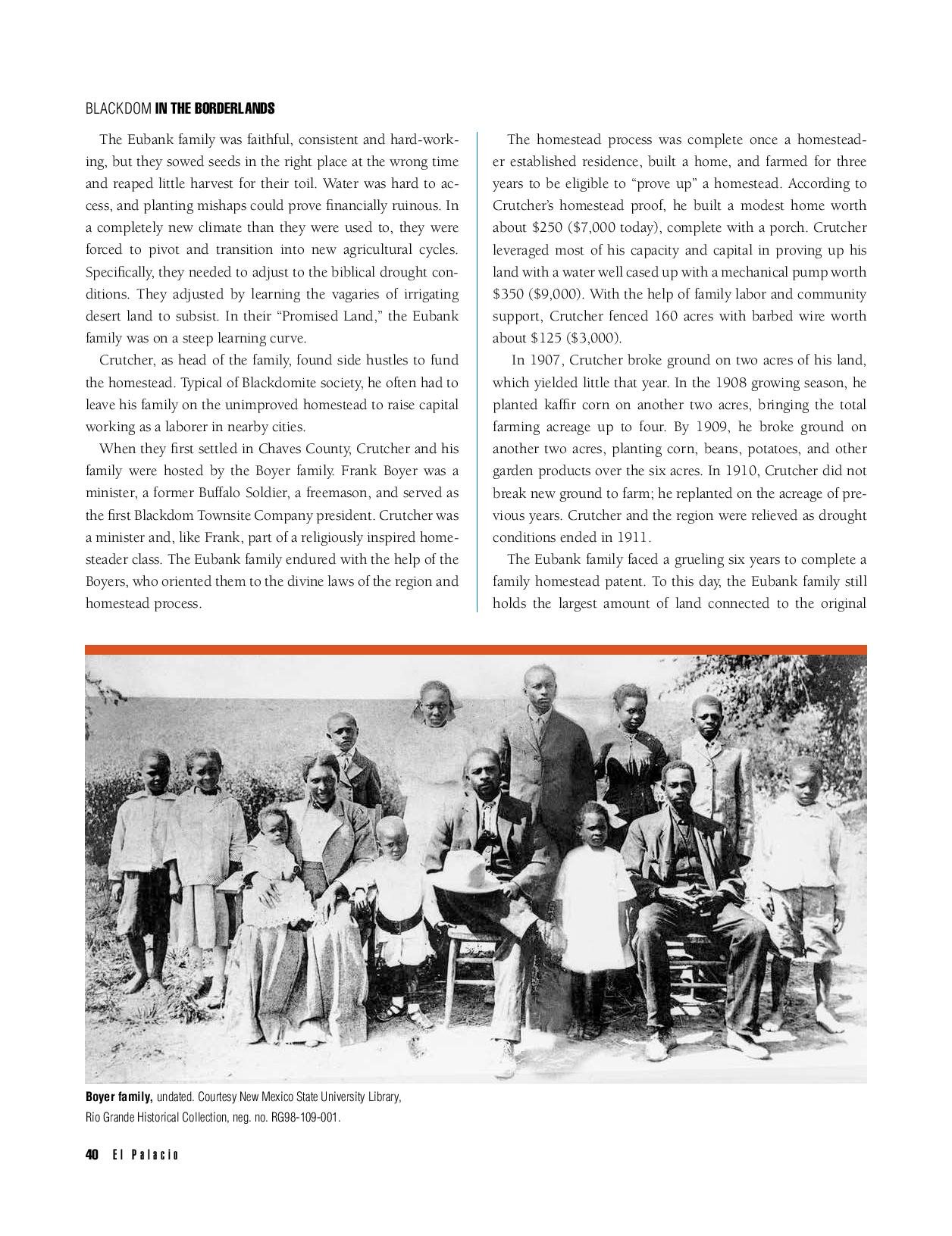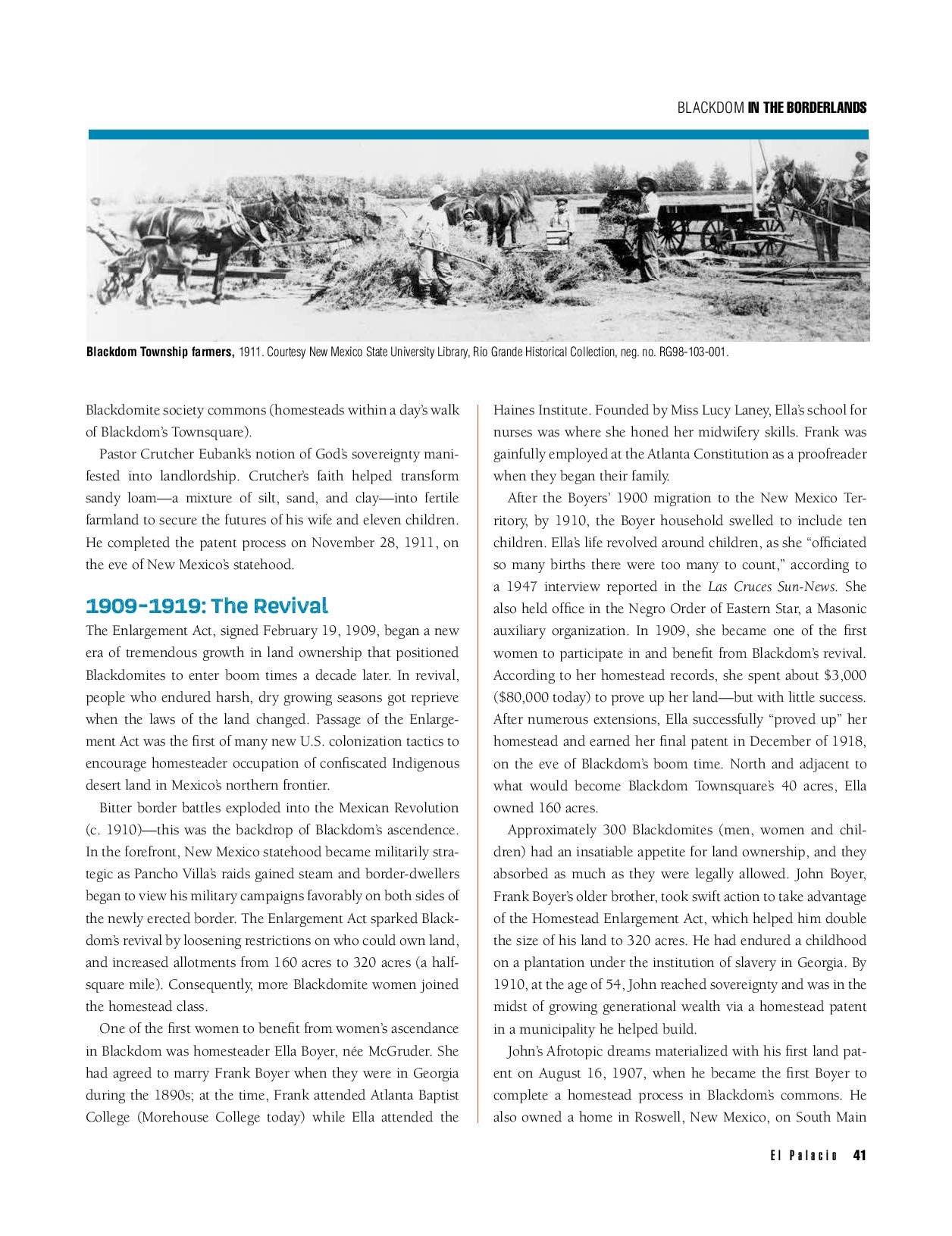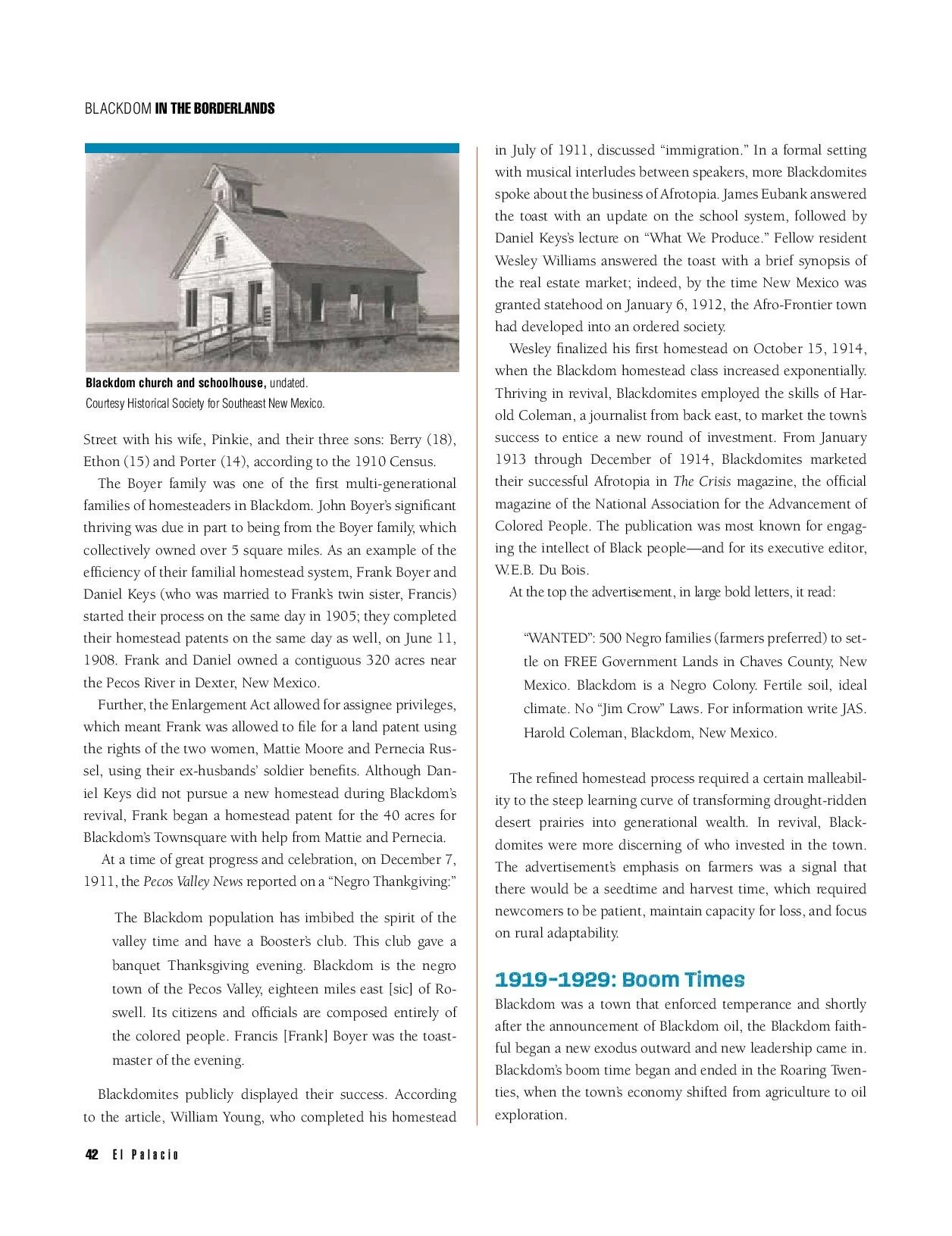El Palacio Magazine. Published by the New Mexico Department of Cultural Affairs. Spring 2021. Vol. 126 / No. 1
Blackdom in the Borderlands
Significance of the Afro-Frontier (1903-1929)
New Mexico State Dept of Cultural Affairs 107-year-old El Palacio Magazine is featuring the first article about the history of Blackdom, New Mexico. ~Written by Historian Timothy E. Nelson, Ph.D. #BlackdomRenaissance #BH365 #BorderlandsHistory
The Unedited Version Below
〰️
The Unedited Version Below 〰️
Significance of the Afro-Frontier: Blackdom 100 Years Ago
By Dr. Timothy E. Nelson, Historian, Artist
July 2020 during COVID-19 Lockdown
At the turn of the 20th Century, Blackdom was a real place situated in the southeastern section of the New Mexico Territory. The Pecos Valley Region’s economic surge brought workers along with industry as well as human and land exploitation on a global scale to execute some of the largest infrastructure projects in the world at the time. People under the conditions of Blackness (Black People) sought opportunity in the colonization collision at the intersection of Mexico’s Northern Frontier and the U. S. Western Frontier. The interior of the North American continent hosted two different centuries long colonization schemes and Black People developed their own frontier amidst the chaos of the parallel Borderlands often acting as a buffer. The first colonization scheme launched as a northward exploitation of Indigenous peoples and lands in the late 1400s and a second wave colonization scheme was a westward evasion launched in the late 1500s; all from continental Europe. By 1900, the lack of full colonization by a singular force or hegemon in the Mexico-U.S. Borderlands provided opportunities for Black People seeking sovereignty through a unique form of trans-colonization in their development of an Afro-Frontier. Inspired by the explosion of commerce, in September of 1903, thirteen men who represented scores of family and kinfolk, walked into the Chaves County Clerk’s Office and incorporated the Blackdom Townsite Company. On December 31, 1919 Blackdomites succeeded in achieving generational wealth with the advent of the Blackdom Oil Company. In May of 1920, Francis (Frank) Marion Boyer, the townsite companies first president and his wife Ella (McGruder) Boyer, filed the official plat of the town and commons. Blackdom’s era of boom times began at the start of the “Roaring 20s and ended after the economic collapse of 1929. The Great Depression ended Blackdom’s town relations and the Dust Bowl ended all prospects of town revival during the pre-WWII era. Nevertheless, according to Frank, Blackdom’s oil company continued to produce royalties for the homestead class in post-WWII America. Blackdom was a grand scheme in the niche business of Black Towns for profit. Blackdom became an institution that nurtured ideas and fostered sovereignty for people of African descent in diaspora. At the intersection of Mexico’s Northern Frontier and the U.S. Western Frontier, New Mexico offered Black People a unique freedom to achieve sovereignty. Lack of Jim Crow Law enforcement afforded Black People authority over their lives and financial futures of their children’s children. Propelled by religious fervor and influenced by the ideas cultivated in the New Negro Movement, and refined by Negro masonic institutions,Blackdomites oriented themselves to a primordial colonization continuum that began in (so-called) Africa during antiquity. Peoples of the African Diaspora often suffered the physical condition of Blackness; a legal status codified into supreme law of their diasporic host land and the law was often fortified with coercion. Blackdom was a case study in the notion of separate-and-equal that Black people interpreted as opportunity in the legal doctrine of Separate-But-Equal (Plessy v. Ferguson May 18, 1896).
In New Mexico, Blackdom mimicked the sovereignty of Africans in “antiquity”. Ethiopia represented a people and culture of sovereigns before the technology of Whiteness was invented. Ethiopianism wrapped in Liberation Theology of the Christian traditions, and refined by masonic understandings, Black people were freely able to exist as God’s first sovereign people. Mortality after infection from euthanizing viral notions was abated, there were little to no consequences of other people’s belief in White Supremacy. The significance of the Afro-Frontier town was reflected in the unveiling of Black intentionality allowed to unfold with the lack of integration or arresting of sovereignty when Blackness didn’t quarantine.
The Lost Years | 1903 - 1909
The Eubank Family currently holds the largest amount of land connected to the original Blackdomite society commons (within a days walk of Blackdom’ town square). Crutcher Eubank was a minister and led one of the waves of migrants to the Afro-Frontier of Chaves County. Crutcher was representative of the religious homestead class who found meaning in the harshness of proving up a homestead on dry desert prairies. He was born in Kentucky at the end of named slavery, watched the rise of the Ku Klux Klan and migrated to Southeastern New Mexico going beyond freedom seeking sovereignty in his late forties. Married with eleven kids, he began his homestead patent process on October 9, 1906. November 10, 1926, Frank and Ella Boyer quit-claim deed to Crutcher Blackdom’s 40 acre Townsite. Cruthcer Eubank was the pastor of Blackdom’s first church and his legacy of sovereignty manifested in land ownership and immortalized in deeds as well as land patents. Crutcher’s vision produced generational land ownership; a projection of intentionality. He had faith in God to transform sandy loam; mixture of silt, sand, and clay to secure the futures of his 11 children. He built a small home, with a porch, worth about two hundred fifty dollars ($7,000 adjusted for inflation); modest back then. Crutcher leveraged most of his capacity and capital in proving-up his land with a well cased up with a mechanical pump worth three hundred fifty dollars ($9,000 adjusted for inflation). With the help of family labor, Crutcher fenced one hundred sixty acres with three and four-barbed wire worth about one hundred twenty-five dollars. In November of 1911, Crutcher was fifty years of age when he filed his Final Proof. His endurance showed intention, sacrifice, cost and benefit analysis. Droughts made feeding the family off of subsistence dry-farming hard to overcome. He had to stop work on his land to work on neighboring farms as well as in nearby towns, and cities to survive. From the beginning, Crutcher was forced to leave his family on the unimproved homestead land to earn money on jobs that took him away for weeks at a time. In 1907, he broke ground on two acres of his land, which yielded very little that year. In the 1908 growing season, he planted kaffir corn on another two acres, bringing the total farming acreage up to four. By 1909, he broke ground on another two acres, planting corn, beans, potatoes and other garden products over the six acres. In 1910, Crutcher did not break new ground to farm; he replanted on the acreage of previous years. After a grueling six-year period (three years was a normal process), he finally filed for the completion of his homestead patent on Tuesday, November 28, 1911, in time to announce at the annual Blackdom Thanksgiving banquet. Pastor Eubank not only preached about faith, he chose to live the life homesteading in the New Mexico desert during the winter planting kaffir corn, a warm-weather plant. This corn variety has a slow early growth and wasn’t ideal to plant in cold ground. Crutcher quickly learned that if planted too early, a late replanting was needed and made growing in the way he did extremely inefficient. Even worse, if a good stand was secured in the first planting, the growth of the young plants would grow slowly, weeds aggressively grew, and more cultivation was needed.
During Blackdom’s lost years (1903-1911), the idea of building a town based on a farming culture seemed far fetched and akin to believing in miracles. Crutcher’s future was uncertain because his decisions almost led to generational economic disaster. Crutcher as well as other Black farmers in the region were relieved when a prolonged drought that ended in 1911. Crutcher prayed, the rains came and drought conditions did not return until after 1916. The next generation had choices and Crutcher had to endure their free will. The lost years encapsulated a time of sifting through those faithful to the cause and those discouraged by the seemingly inevitable failure. James Eubank was a part of Blackdoms first cohort of teachers and did not homestead and follow the path of his father Crutcher.
The Revival (1909-1919)
John Boyer endured a childhood under the institution of slavery, in Georgia. By 1910, at the age of 54, John reached sovereignty in the form of a homestead patent in a municipality of Blackdom he helped build, along with a house in Roswell, New Mexico on South Main Street. John and his wife, Pinkie, had 3 sons (age) : Berry (18), Ethon (15) and Porter (14). John's significant thriving was due in part to the tremendous amount of cultivation by the Boyer family to improve chances of good homestead outcomes. Francis L. Boyer, John’s younger sister, married Daniel Keys who homesteaded adjacent to Frank Boyer, in Dexter, New Mexico, and Daniel was able to start the same day and earn his patent the same day as Frank. Individual hard work, sacrifice and collective actions helped the early settlers who endured to enter into a revival of all-black municipality ideas. The process was refined enough to get predictable outcomes. More importantly, the catalyst of new supreme laws of the land in 1909 (Homestead Act) had two major advantages for the revival of Blackdom’s township. The Enlargement Act, signed February 19, 1909 double homestead allotment from 160 acres to 320 and was important for the individual Blackdomites. Collective in the new act enlarging non irrigable Western frontier land, the new law also allowed for assignees to property. Frank Boyer, the leading visionary of the frontier scheme, saw the opportunity to connect the idea of Blackdom to land.
Assurance of assignee privileges allowed more women to participate in the homestead process. Mattie Moore, Pernecia Russell, and Ella Boyer were a few who benefited. Mattie with 35 acres and Pernecia with 5 acres together they chose Frank Boyer as assignee for the 40 acres of land that became Blackdom Townsite. In part, the new rule about land was a way to appease the military class as a war tactic to help with the efforts of colonizing the Borderlands in the New Mexico Territory. Soldiers' benefits allowed 42 year old Mattie from Doley County, Texas to stake a claim of government land as heir to Dickson Garner under the provision of soldiers survivor benefits to get additional homestead rights. The Mexican Revolution of 1910 helped colonizers of New Mexico leverage the U.S. Government to transition a federal territory into a state. The political leaders of New Mexico along with the coercion of Whiteness would shift federal powers to local governing entities leaving the fate of sovereignty for Black bodies in jeopardy. Impending statehood and the ultimate shift to sovereignty defined by local Southern confederate politically leaning White people 20 miles North accelerated the growth of Blackdom’s homestead class.
December 7, 1911, the Pecos Valley News reported, “Negro Thankgiving:” The Blackdom population has imbibed the spirit of the valley time and have a Booster’s club. This club gave a banquet Thanksgiving evening. Blackdom is a the negro town of the Pecos Valley, eighteen miles east [sic] of Roswell. Its citizens and officials are composed entirely of the colored people. Francis [Frank] Boyer was the toastmaster of the evening. Toasts were responded to by….
The Afro-Frontier town had developed into an ordered society in the time of New Mexicobecoming the 47th state on January 6, 1912. Frank’s toast was followed by William Young discussing the status of immigration toBlackdom and developments in the overall process. William completed his first homestead process July 1, 1911. James Eubank answered the toast with an update on the school system. Daniel Keys lectured on, “What we produce.” Blackdom’s Real Estate matters took center stage with Wesley Williams who finalized his first homestead, October 15, 1914. Blackdom Townsite and Blackdomites grew and thrived in revival time. The striving was not without losses along the way.
In 1913, the patented Blackdom process to sovereignty was marketed as the Afrotopia of the future. However, in the Crisis magazine, February 1913 issue, Blackdomites advertised, “farmers preferred.” The refined homestead process required a certain malleability to the steep learning curve striving in an agri-cult society focused on transforming drought-ridden desert prairies into generational wealth. Harold Coleman, Blackdom’s advertising manager from back east handled the layout; at the top, “WANTED” 4 times as large as the remaining words that read 500 Negro families (farmers preferred) to settle on FREE Government Lands in Chaves County, New Mexico. Blackdom is a Negro Colony. Fertile soil, ideal climate. No “Jim Crow” Laws. For information write JAS. Harold Coleman Blackdom, New Mexico Free was relative and the ideal climate depended on perspective. More important than the other selling points, no Jim Crow Law and enforcement meant the striving spoken of by W.E.B. Du Bois and Booker T. Washington had the potential for realization. The emphasis on farmers was a signal that there would be a seedtime and harvest time which required newcomers to be patient, maintain capacity for loss and the adaptability of rural peoples for best outcomes. Coleman knew of the hardships that came with life. His advertisements were published in Crisis Magazine issues until December of 1914.
Although the Boyer Family perfected the homestead process, Frank was near bankruptcy as Blackdom grew. Nevertheless, Blackdom Townsite served as his temporary refuge before he proceeded to continue his sovereignty project. Ella began her homestead patent during the fervor of the 1909 allotment increase to a half a square mile (from 160 to 320 acres). February 19,1914, Ella was granted an extension to submit her final proof December 1, 1915. The new law required Ella to be deposed and prove her claim within 60 days, and pay the receiver at the land office the sum of 50 cents per acre. If Ella were not to complete her proof by the deadline, she would forfeit her whole investment and rights to the land adjacent to Blackdom’s town square.
Boom Times (1919 - 1929)
Blackdom Oil Company’s decade-long existence ended an era. On October 24, 1929, the world economic market crash, followed by the Great Depression, ended Blackdom’s history. The economic collapse ended the ability of Bladomites to muster in the town square. Oil exploration required that speculators take on massive amounts of debt. After 1929, many companies and municipalities suffered from a lack of liquidity in financial markets. In 1947, Frank Boyer the only Negro Oil company ever formed. In fact, Blackdom Oil was a part of a cohort of Black owned oil companies in frontier space. Frank passed away on his lush acreage in Vado, New Mexico 2 years after his final interview with Kathryn Henry, a reporter for the Clovis News-Journal. Frank Boyer, Justice of the Peace in Blackdom decided to take half of Blackdomite society to Doña Ana County, New Mexico. Frank’s departure coincided with the vision of Blackdom moving from an agrarian society to a municipality fueled by the boom and bust cycles of exploration. Oil royalties helped sustain Blackdomites hundreds miles away from Blackdom town square. Frank died the Grand Corresponding Secretary of his Prince Hall Freemason fraternal order. Although he decided to lead an Afrotopia 200 miles South of Blackdom, he frequently traveled back to Roswell for fraternal meetings and to pick up his royalty checks. Uniting Black Ministers, Black Military and Black Freemasons allowed Frank Boyer to succeed in quarantine. Frank set a course for generational wealth in the Boyer family after his passing. Most redeeming, his father Henry Boyer, who was born under the institution of slavery passed away, sovereign. Henry was born October 29, 1822, in Hancock County, Georgia on the plantation of Elias Boyer. Since 1875, Henry Boyer nurtured his belief in sovereignty in the Ethiopianism of the African Baptist Church’ liberation theology. Henry married Hester Hill and Frank Boyer was the last of their 17 children, and was the first of a generation born free. Henry passed away at the age of 103 at the home of his son, Henry Boyer Jr., in Rowell, New Mexico on South Kansas Street at 10 o’clock (am or pm), February 24, 1926. Henry was survived by 5 of his children, John Henry Jr., Robert S., Frank and Henry’s daughter, Mrs. M. V. Johnson. Henry’s great wealth at his passing was measured in 38 grandchildren and sovereignty. Henry’s mother and Frank’s grandmother, Aggie Boyer, were born sovereign in West Africa before her sovereignty was interrupted by being forced into the institutions of slavery in the United States. For people under the conditions of Blackness in America, the trajectory from freedom to sovereignty was often interrupted by the institutions of the Atlantic Slave Trade. Frank’s departure changed the culture of Blackdom’s business dealings. No one benefited more than Mittie Moore Wilson from the town's economic shift from agrarian to oil exploration. She was a bootlegger at a time Blackdom was a municipality that enforced Christian Temperance and applauded the advent of the Volstead Act. Ratified on January 16, 1919, Frank as Peace Officer had the authority of supreme law of the land to enforce the National Prohibition Act. Infamously, Mittie Moore, at the height of Blackdom’s revival, was ensnared in a New Mexico Supreme Court case because of her bawdy business as a madam. She ran her empire from 201 S. Virginia Ave. in Roswell, New Mexico. Blackdom’s church was built in 1915 and sold to First United Methodist Church of Cottonwood in the summer of 1922. Cottonwood was a settlement 15 miles South of Blackdom where an offshoot of Black people began colonizing similar to Blackdomites. The original purpose for the town and religious ideals waned as the prospect of grand fortunes fueled the frenetic pace of Black homesteaders investing in Blackdom commons. The Blackdom Oil Company’s patented landholding began with 10,000 acres when rumors circulated in the summer of 1919 “Red Summer”. In September, Mittie was allowed to add her whole square mile to the 10,000 acres announced on December 31, 1919 in the Roswell Daily Record. Mittie completed her proving documents on February 25, 1922.








